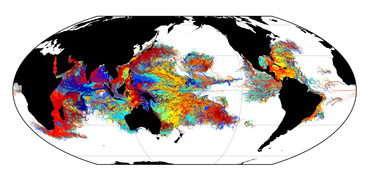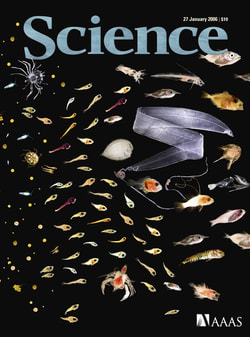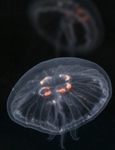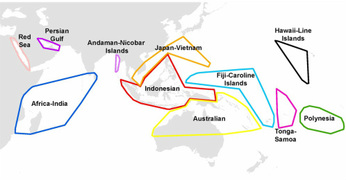Modelling marine dispersal
|
The oceans are constantly moving - redistributing amongst other things organisms, nutrients, oxygen and heat, as well as 'undesirables' such as pollutants, debris and invasive species. However, determining the movement of often minute objects in the vast and ever-changing oceans is a difficult task. My research combines oceanographic model output with biological data to predict how marine organisms are transported by ocean currents. To do this I use the Connectivity Modelling System (CMS), developed by Claire Paris and colleagues at the Rosenstiel School of Marine and Atmospheric Science, U. Miami. CMS has been used to model the movement a wide range of biological and non-biological objects in the oceans; from oil spills to marine plastic to the larvae and adults of a variety of marine species.
"Fundamentally, the reason for modelling is a lack of full access, either in time or space, to the phenomena of interest” |
Jellyfish bloom dispersal in the North Sea
|
The sudden, en-masse appearance of large numbers of jellyfish, known as blooms, causes problems for tourist beaches, coastal power plants and fish farms. We are developing a method to rapidly predict the dispersal of jellyfish blooms as they are detected, using the North Sea as a test case. Read more here.
Image: The moon jellyfish Aurelia aurita, recently seen in large numbers in UK waters (image: J Craggs) |
Coral reef isolation and connectivity
Coral reefs are some of the most diverse and valuable ecosystems on Earth. They are also among the most vulnerable, coming under increasing threat from direct human activity and the effects of climate change. How coral populations will respond to these pressures will depend to a large extent on their ability to disperse in the oceans - in order to replenish damaged populations, migrate to escape deteriorating conditions and colonise new habitats under a changing climate.
 Modelled larval paths from over 12,000 global reef locations
Modelled larval paths from over 12,000 global reef locations
Immobile as adults, reef-forming corals disperse between fragmented marine habitats by releasing a free floating larval stage into the water. These larvae drift with the ocean currents over potentially vast distances until they find a suitable new home, where they settle onto the ocean bottom and transform into an adult coral to start a new colony. This process is important for healthy reef populations, affecting how quickly they are able to recover following a disturbance, such as bleaching or disease. Reefs that are isolated from other populations can suffer from a lack of genetic diversity and limited ability to recover from disturbances.
However, released in their billions and less than mm’s in size, larvae are impossible to track directly in the open ocean. I am using biophysical modelling to simulate the dispersal of coral larvae by ocean currents, mapping potential connections and levels of isolation between reefs globally.
Working with the Baums laboratory at Penn State University, we are also developing methods to compare dispersal modelling output with genetic data for coral species, providing information of relevance to the study of coral biogeography.
Working with the Baums laboratory at Penn State University, we are also developing methods to compare dispersal modelling output with genetic data for coral species, providing information of relevance to the study of coral biogeography.
|
The role of dispersal in shaping coral biogeographic patterns
Reef-building coral species assemblages differ between regions in terms of both the number and identity of species present. Using our global coral dispersal model output, Sally Keith and Neil Maginnis at the Center for Macroecology Evolution & Climate in Copenhagen have been comparing the role of connectivity with that of environmental conditions in generating similarity between coral assemblages across the Indo-Pacific.
|
Keith, S. A., et al. (2013). "Faunal breaks and species composition of Indo-Pacific corals: the role of plate tectonics, environment and habitat distribution." Proceedings of the Royal Society B: Biological Sciences 280(1763).
Oreskes, N., et al. (1994). "Verification, Validation, and Confirmation of Numerical Models in the Earth Sciences." Science 263(5147): 641-646.
Oreskes, N., et al. (1994). "Verification, Validation, and Confirmation of Numerical Models in the Earth Sciences." Science 263(5147): 641-646.



